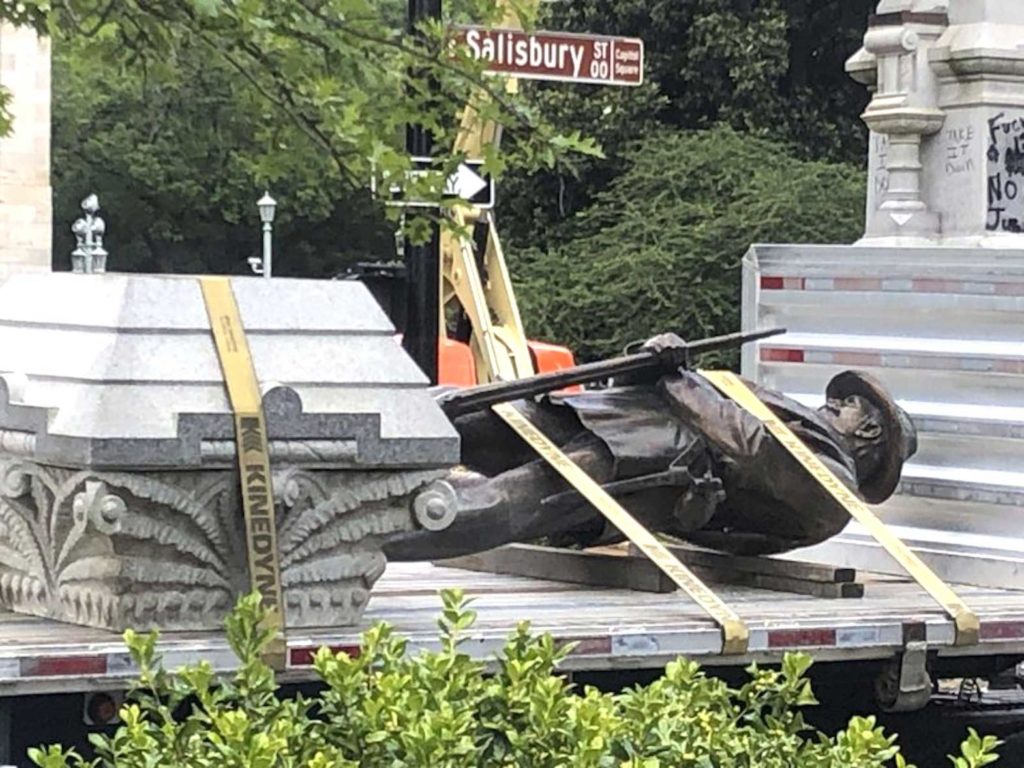
The statue of a Confederate soldier and plinth sit on a flatbed truck at the Old Capitol in Raleigh, N.C., on Sunday, June 21, 2020. After protesters pulled down two smaller statues on the same monument Friday, North Carolina Gov. Roy Cooper ordered the removal of several other monuments to the Confederacy, citing public safety concerns. (AP Photo/Allen G. Breed)
The killing of George Floyd sparked mass protests that have also taken aim at symbols of slavery and Black oppression: Confederate monuments.
Protesters have been taking down statues built many years ago to honor the leaders of the American South during the Civil War who fought for the right to own slaves in the United States.
They lost.
But what happened after the war offers an important lesson to Filipinos, a powerful reminder of how important it is to teach our children about history, especially as we see vile attempts to distort our own by supporters of the dictator Ferdinand Marcos are pushing to erase that brutal past.
The generals and leaders who wanted to preserve slavery may have lost the Civil War. But here’s the amazing twist: their descendants actually managed to spread the false message for decades that they fought a totally honorable war that didn’t have anything to do with wanting to continue the exploitation and enslavement of other people.
This campaign was dubbed “The Lost Cause.” You can check out a number of engaging documentaries about it on YouTube like this one produced by Vox.
“The Lost Cause is one of the most notoriously effective efforts to rewrite history and it was done by the losing side,” the Vox documentary says.
The movement was led by the United Daughters of the Confederacy which was founded in the 1890s and whose goal was purportedly to preserve Confederate culture — which essentially meant to gloss over the evils of slavery and to deny that that’s what their ancestors were fighting for.
One of the ways they did this is by building monuments all over the South, which they were able to do because of their political power. And that’s why today’s civil rights protesters have been pushing to remove them.
Now, targeting these monuments is controversial. I generally agree with the respected activist Andrew Young, who had marched with Martin Luther King in the battles for civil rights in the 1960s, and who has raised questions about the campaign against the monuments.
“I think we have got to be together in defining what we want the future to stand for,” he said recently at a Rotary Club meeting in Atlanta. “It doesn’t mean destroying the past. It means learning from the past.”
Three years ago, as the Black Lives Matter movement was getting started, Young also said in an interview with NPR, “I’m saying these are kids who grew up free, and they don’t realize what still enslaves them — and it’s not those monuments.”
That echoed a point Karen Cox, a University of North Carolina history professor, raised in the Vox documentary, as she explained the far more serious harm that the Lost Cause campaign caused.
“Monuments are the least of what they did,” she said in the documentary.” I mean they’re the most visible and tangible. But the work with children was far more influential.”
And this focused mainly on shaping the way children viewed the past.
For decades, the descendants of the Confederate leaders managed to control the way the Civil War and slavery was taught in schools in the South, including the textbooks and curricula used to education generations of Americans.
And the message was summed in three points:
- That the Confederate leaders who went to war to defend slavery were heroes.
- The Black slaves in the South were actually happy.
- And the Civil War was not really about slavery.
It’s the twisted master narrative that was perpetuated by the advocates of slavery who were defeated in the Civil War in a huge region of America for generations.
Watching this documentary and learning more about the Lost Cause campaign reminded me of our great failure in the Philippines.
More than 30 years ago, Filipinos kicked out a corrupt and brutal dictatorship. But the triumph and the lessons on how a tyrant managed to deceive his way to power have not been passed on adequately to young Filipinos.
This failure has led to a vague understanding of a dark chapter in our country’s history. And it created openings for leaders who inspired mass killings and who abused their power — like Duterte.
This great failure was underscored late last year when my alma mater, the University of the Philippines, announced that it was finally going to offer a class on the martial law era. That’s more than 30 years late — but hopefully it’s a start and the effort will spread throughout the archipelago.
For as the historian Kevin Levin said in the documentary on how the descendants of the generals who lost their bid to preserve slavery in the American South, “They understand that how you educate, who wins the writing game and who wins the battle over history ultimately wins the war.”
Visit the Kuwento page on Facebook

